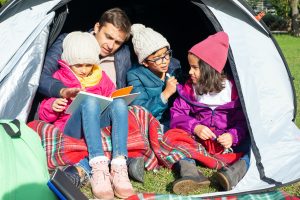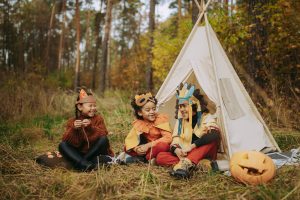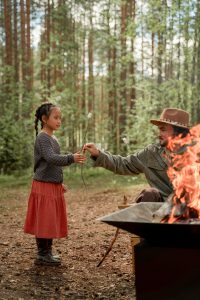Are you planning a tent camping trip with your kids? If so, you’re in for an unforgettable adventure! With the right preparations and mindset, you can ensure a fun and safe trip for the whole family. In this article, you’ll find 10 handy tips that will help you make the most of your outdoor excursion. From choosing the perfect campsite to packing essential items, you’ll discover everything you need to know to create lasting memories and keep your little ones entertained and safe throughout your camping experience. So, grab your camping gear and get ready for an amazing adventure in the great outdoors!

This image is property of images.pexels.com.
Choosing the Right Campsite
When planning a tent camping trip with your kids, one of the first things you need to consider is the location and accessibility of the campsite. Look for a campsite that is easy to reach, especially if you have young children. Consider how far it is from your home and whether there are any amenities nearby, such as grocery stores or medical facilities. Additionally, think about the type of environment you want to expose your kids to. Do you prefer a campsite in the mountains, by a lake, or in a forest? Ultimately, choose a campsite that suits your family’s preferences and needs.
Another important aspect to research when choosing a campsite is the amenities and facilities available. Some campsites offer amenities such as showers, restrooms, and laundry facilities, which can greatly enhance your camping experience. Look into whether there are hiking trails, playgrounds, or swimming areas nearby for your kids to enjoy. Additionally, consider if the campsite allows pets if you plan to bring along your furry friends. Researching the amenities and facilities beforehand ensures that you choose a campsite that meets your family’s expectations and provides the necessary conveniences for a comfortable stay.
Preparing and Packing
To avoid any last-minute hassles, it’s important to create a camping checklist. Jot down all the essential items you need to bring, such as camping gear, cooking utensils, and personal items. Include items specific to your children, such as extra clothes, diapers, and their favorite toys. A checklist helps you stay organized and ensures that you don’t forget any important items.
When it comes to clothing and footwear, pack appropriate attire suitable for the weather conditions at the campsite. Be prepared for changing temperatures by packing layers, including light jackets and raincoats. Choose sturdy footwear that can withstand outdoor activities and provide comfort while hiking or exploring.
Bring along essential camping gear such as a tent, sleeping bags, and camping chairs. Check that all the necessary components of your tent are included and in good condition. It’s always a good idea to practice setting up the tent beforehand, especially if it’s your first time or if you’ve recently purchased a new one. This way, you’ll be well-prepared and confident when you arrive at the campsite.
Preparing meals while camping can be challenging, especially with kids. To make it easier, plan and pack easy and nutritious meals. Opt for simple recipes that don’t require extensive preparation or cooking time. Pre-cut and pre-pack ingredients to save time and reduce waste. Consider meal options that are kid-friendly and appeal to their taste buds. Don’t forget to bring a cooler to keep perishable food items fresh.

This image is property of images.pexels.com.
Setting Up the Tent
Setting up the tent is an essential part of the camping experience, and it’s crucial to get it right to ensure a comfortable and safe stay. Before heading to the campsite, practice setting up the tent in your backyard or at a nearby park. This will help you become familiar with the process and identify any potential challenges or missing components.
When selecting a tent, choose a suitable size that accommodates your whole family comfortably. Consider the number of people sleeping in the tent and the amount of gear you need to store. A larger tent may provide more space to move around, but it can also be harder to set up and take down. Take into consideration the ease of assembly when selecting the right size.
Once you’ve arrived at the campsite, find a level and debris-free ground to set up your tent. Clear away any rocks, branches, or other potential discomforts that may hinder your sleep. It’s also important to consider the weather conditions when positioning your tent. Avoid setting up in low-lying areas where water may accumulate during rainfall. Choose a spot that offers shade during hot days and protection from strong winds if possible.
Safety Measures
When camping with kids, it’s essential to prioritize their safety. Before embarking on your camping trip, take the time to educate your kids about potential camping hazards. Teach them about the dangers of open flames, poisonous plants, and wild animals. Establish clear boundaries within the campsite and instruct your children to stay within those boundaries to ensure their safety.
Additionally, teach your kids basic first aid skills, such as how to clean and dress a wound, and when to seek adult help. Prepare a first aid kit that includes essential items such as bandages, antiseptic wipes, and pain relievers. Familiarize yourself and your kids with the contents of the first aid kit and their appropriate uses.
When packing for your camping adventure, make sure to include essential safety items such as flashlights, batteries, and a whistle. Flashlights come in handy during the night for navigating around the campsite and can be a source of entertainment for your kids. Whistles can be used to call for help in case of an emergency, and it’s important to teach your children how and when to use them.

This image is property of images.pexels.com.
Keeping Kids Entertained
To ensure a fun-filled camping trip for your kids, plan engaging activities and games that they can participate in. Research the campsite beforehand to identify any specific activities or attractions nearby that will appeal to your kids’ interests. This could include hiking trails, swimming areas, or nature centers.
Pack outdoor toys and sports equipment to keep your kids active and entertained during the day. Include items such as frisbees, balls, and bicycles. These items not only provide entertainment but also encourage physical activity and exploration.
Encourage your kids to explore nature by initiating nature hikes or scavenger hunts. Provide them with a list of items to find or identify, such as different types of leaves, rocks, or animal tracks. This will not only keep them engaged but also foster their curiosity and appreciation for the natural world.
Nighttime at the campsite is the perfect time for storytelling and campfire activities. Bring along a book of campfire stories or create your own stories to share with your kids. Encourage them to participate by taking turns telling stories or acting them out. Building lasting memories around the campfire is an essential part of the camping experience.
Campfire Safety
Campfires are a beloved part of camping traditions, but it’s important to follow campfire regulations and restrictions to ensure everyone’s safety. Before starting a campfire, research the campsite’s policies regarding open flames and check for any fire bans or restrictions due to weather conditions.
When there’s a campfire, ensure to supervise children around it at all times. Teach them about fire safety rules and procedures, such as keeping a safe distance, not playing with fire or throwing objects into the fire, and not leaving the fire unattended. It’s important to emphasize the importance of responsible behavior around fires to prevent accidents and injuries.
Before leaving the campsite or going to bed, extinguish the fire properly. Pour water over the fire, making sure to thoroughly douse the flames. Stir the ashes and embers to ensure everything is completely extinguished and cool to the touch. Leaving a fire unattended or improperly extinguished can lead to wildfires, so it’s crucial to take this step seriously.
Sleeping Comfortably
A restful night’s sleep is crucial for an enjoyable camping experience, especially when you have kids. Choose appropriate sleeping gear that provides comfort and insulation. Sleeping bags are a staple for camping trips, and it’s important to select ones that are suitable for the temperatures you’ll encounter. Look for sleeping bags with insulation and temperature ratings that match the climate of your campsite.
Aside from sleeping bags, don’t forget to bring cozy blankets and pillows to make your sleeping area more comfortable. These familiar items from home can help ease any discomfort your children may have while sleeping in a different environment.
Create a comfortable sleeping area by laying out sleeping pads or inflatable mattresses underneath your sleeping bags. These can provide cushioning and insulation from the ground, resulting in a better night’s sleep. Encourage your kids to help set up their sleeping area, allowing them to take ownership and feel more comfortable in the camping environment.
Maintaining a consistent bedtime routine while camping can also help in ensuring a good night’s sleep. Follow a similar routine to the one at home, including activities such as storytime or a quiet game before bed. Familiarity and routine can help your kids relax and fall asleep more easily.
Hygiene and Sanitation
Hygiene and sanitation are important aspects of camping, especially when you have kids. Pack personal hygiene essentials such as toothbrushes, toothpaste, soap, and hand sanitizer. Consider each family member’s specific needs and ensure you have enough supplies for the duration of your trip.
Set up a campsite restroom area that is separate from the cooking and eating areas. Depending on the campsite’s facilities, this may involve using portable toilets or designated restroom areas. Teach your kids about proper bathroom etiquette and the importance of keeping these areas clean.
Make sure to bring along biodegradable soap and follow leave-no-trace principles when washing dishes or bathing. Dispose of soapy water properly and away from any water sources to prevent contamination. Encourage your kids to be mindful of their impact on the environment and to always clean up after themselves.
Handwashing is crucial, especially when camping. Teach your kids proper handwashing techniques, emphasizing the importance of washing with soap and water for at least 20 seconds. Set up a handwashing station with a water container, soap, and towels or hand sanitizer for quick cleanups when water may not be readily available.
When it comes to waste disposal, it’s important to educate your kids about responsible practices. Pack garbage bags for collecting trash and make sure to properly dispose of them in the designated trash receptacles. Consider recycling when possible and teach your kids about the importance of protecting the environment.
Dealing with Insects and Wildlife
Encountering insects and wildlife is part of the camping experience, and it’s important to take precautions to ensure everyone’s safety. Use insect repellent and protective clothing to minimize the risk of insect bites. Make sure that insect repellent is safe for children and always follow the instructions for application.
To prevent attracting wildlife, keep all food properly stored in sealed containers or coolers. Avoid bringing any scented items into your tent, as they can attract animals. Dispose of food waste properly and avoid leaving garbage or food scraps outside of designated trash receptacles. By practicing responsible practices, you can minimize encounters with wildlife and maintain a safe camping environment.
Familiarize yourself and your kids with wildlife safety guidelines for the specific area where you’ll be camping. Teach your kids about the dangers of approaching or feeding wild animals and the importance of observing them from a safe distance. Encourage them to appreciate wildlife in its natural habitat without disturbing or harming it.
Leave No Trace Principles
Teaching kids about environmental stewardship is an essential part of camping. Familiarize your kids with the Leave No Trace principles, which encourage responsible behavior and minimize the impact on the environment.
Minimize campsite impact by choosing established campsites whenever possible. Avoid creating new trails or disturbing vegetation. Set up your campsite in a way that minimizes damage to the surrounding environment.
Properly dispose of trash and recycling to prevent littering. Pack extra bags to collect any trash generated during your camping trip and make sure to dispose of it in the appropriate containers. Teach your kids about the importance of leaving the campsite cleaner than you found it.
Respect wildlife and vegetation by observing from a distance and refraining from picking flowers, removing plants, or damaging trees. Educate your kids about the importance of preserving nature and the impact their actions can have on the environment.
By following these guidelines and instilling a sense of responsibility in your kids, you can ensure that your tent camping trip is not only fun but also contributes to the preservation of the natural world around us. Enjoy your adventure and create lasting memories with your family in the great outdoors!